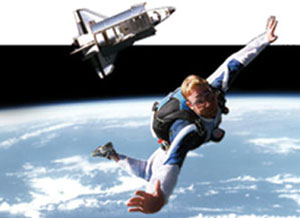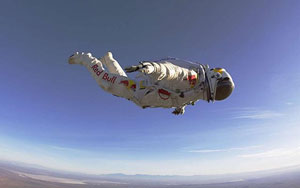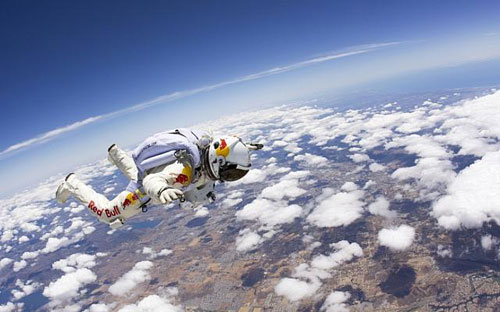Surviving a Plunge From Space
Imagine yourself in orbit high above the Earth's tranquil blue and green orb.

Photo from: http://www.window.state.tx.us

Photo from: http://www.unspeakable.org/gallery/wallpapers/Sports/Extreme-Sports/Redbull-Stratos-Space-Diving
Suddenly, a chunk of wandering space debris leftover from a junked communications satellite causes a catastrophic failure. You have to abandon ship.
That scenario, however unlikely for today's International Space Station astronauts, could become increasingly necessary as private spaceships take to the skies.
Meteorites, solar storms, and debris from a growing amount of space junk can strike with little warning. NASA estimates there are some 21,000 orbiting debris larger than 10 centimeters.
This has engineers dreaming up the technology to allow a space-farer -- be it NASA astronaut or paying space tourist -- to survive a dive from hundreds of thousands of feet up.
The spacesuit used would have to provide the same functions and protection spaceships have from Mercury to the Space Shuttle.
It would also have to protect the fragile human body from supersonic speeds and incinerating temperatures as the atmosphere eats away at it like an incoming meteorite.
Though early jumps were made from the stratosphere in the 1960s, no one has tried since.
A 43-year-old Austrian man intends to change that in the near future.
Felix Baumgartner plans to jump from a distance higher than anyone ever has before --plunging some 120,000 feet. Doing so will require another first as he will reach supersonic speeds with only a pressurized suit to protect him.
A team of more than 100 people and an estimated tens of millions of dollars from Red Bull have helped make the jump a reality.
Speaking to Baumgartner on the radio and advising the project will be 83-year-old Joseph Kittinger. For more than 50-years, the American has owned the records for highest manned balloon flight and jump.
Several years before Alan Shepard became the first American in space and before anyone knew what such a fall would do to the human body, Kittinger jumped from a balloon 75,000 feet above the Earth's surface.
On the first flight in 1959, a near-fatal equipment mishap left a stabilizer parachute chord wrapped around his neck and set his body spinning at a rate of twice a second. Unconscious, Kittinger plummeted toward the ground a record setting 22 times the force of gravity until a parachute automatically released and saved his life.
Incredibly, he jumped again twice in the next 13 months, eventually setting the current jump record of 102,800 feet.
The final flight onboard an open-air gondola, Excelsior III, carried him upward for an hour and a half. On the way up, his right glove lost pressurization and caused his hand to swell up twice its normal size. Kittinger kept quiet about his ballooning hand to stop mission control from scrapping the mission.
Within the first 15,000 feet of his jump he was traveling well over the cruising speed of a commercial jetliner, reaching some 625 mph.
Baumgartner's jump will push the limits even farther, but the Red Bull Stratos team will benefit from the missions five decades earlier. His balloon stretches for 500 feet, significantly larger than the Excelsior balloons. The cockpit is much more modern too.
His parachute consists of three parts, a main chute, an emergency chute and a stabilizing chute called a drogue. Combined with his oxygen system, the pack weighs roughly 60 pounds.
The drogue chute is too small to substantially slow his fall, but it lessens the drag and should keep Baumgartner from spinning out of control the way Kittinger did on his first flight.
If all goes as intended, the pack will slow from the speed of sound down to about 170 mph.
Of course, jumping from orbit would require surviving speeds several times greater than the Red Bull team is anticipating. A drogue failing on an astronaut plummeting back to Earth would not only make them lose consciousness, the spin would rip the body apart.

Photo from: http://www.unspeakable.org/gallery/wallpapers/Sports/Extreme-Sports/Redbull-Stratos-Space-Diving
It's not clear if a drogue could sustain speeds of several thousand miles per hour or if a human can survive supersonic speeds without an aircraft.
The Red Bull team hopes their flights will help answer those questions to make spaceflight safer for the legions of space travelers expected to take to orbit in the coming years.
For more information:
http://www.redbullstratos.com/
http://orbitaldebris.jsc.nasa.gov/faqs.html#3
http://stratocat.com.ar/artics/excelsior-e.htm
http://www.popsci.com/military-aviation-space/article/2007-06/high-dive
http://www.txchnologist.com/2012/get-down-felix-baumgartner-is-space-diving-in-pursuit-of-science














